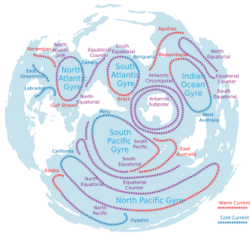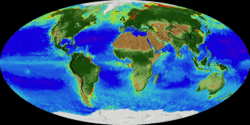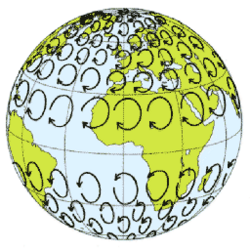Physics:Ocean gyre
In oceanography, a gyre (/ˈdʒaɪər/) is any large system of circulating ocean surface currents, particularly those involved with large wind movements. Gyres are caused by the Coriolis effect; planetary vorticity, horizontal friction and vertical friction determine the circulatory patterns from the wind stress curl (torque).[1]
Gyre can refer to any type of vortex in an atmosphere or a sea,[2] even one that is human-created, but it is most commonly used in terrestrial oceanography to refer to the major ocean systems.
Major gyres
The following are the five most notable ocean gyres:[3]
- Indian Ocean Gyre
- North Atlantic Gyre
- North Pacific Gyre
- South Atlantic Gyre
- South Pacific Gyre
They flow clockwise in the Northern hemisphere, and counterclockwise in the Southern hemisphere.
Other gyres
Tropical gyres
Tropical gyres are less unified and tend to be mostly east–west with minor north–south extent.
- Atlantic Equatorial Current System (two counter-rotating circulations)[citation needed]
- Pacific Equatorial Current System[citation needed]
- Indian Monsoon Gyres (two counter-rotating circulations in northern Indian Ocean)[4]
Subtropical gyres
Subtropical gyres are formed by an intricate process involving both Coriolis force and Ekman transport.[5] As global winds, caused by Earth's rotation, blow across the ocean surface they are acted upon by Coriolis causing movement to the right in the Northern Hemisphere and to the left in the Southern Hemisphere. These winds cause frictional surface currents as the wind transfers energy to the ocean allowing the water to move in a circular motion.[6] As Ekman transport acts on these circular currents the net transport of water is actually 90 degrees which drives regions of convergence, allowing water to pile up in the center of the ocean basin forming a bulge.[7]
The center of a subtropical gyre is a high pressure zone, while the outer edges of the gyre are a low pressure zone. This difference in pressure causes a pressure gradient allowing the diffusion of water from the high pressure zone in the bulge to the low pressure zone on the outer edges of the gyre.The movement of water does not flow directly down the bulge in the center but around it due to Coriolis causing circulation around the high pressure zone in a clockwise motion in the northern hemisphere and a counterclockwise motion in the southern hemisphere.Thus, Resulting in the rotation of the gyre. The gyre has a stable circulation of water around it due to the exact balance between Ekman force and Coriolis. These gyres contribute to the Geostrophic Flow of the ocean resulting in the overall Ocean circulation model of the Earth.[8] The movement of subtropical gyres cause areas of downwelling in the ocean resulting in regions of lower productivity.
This build-up of water in the center creates flow towards the equator in the upper 1,000 to 2,000 m (3,300 to 6,600 ft) of the ocean, through rather complex dynamics. This flow is returned towards the pole in an intensified western boundary current. The boundary current of the North Atlantic Gyre is the Gulf Stream, of the North Pacific Gyre the Kuroshio Current, of the South Atlantic Gyre the Brazil Current, of the South Pacific Gyre the East Australian Current, and of the Indian Ocean Gyre the Agulhas Current.[citation needed]
Subpolar gyres
Subpolar gyres form at high latitudes (around 60°). Circulation of surface wind and ocean water is counterclockwise in the Northern Hemisphere, around a low-pressure area, such as the persistent Aleutian Low and the Icelandic Low. Surface currents generally move outward from the center of the system. This drives the Ekman transport, which creates an upwelling of nutrient-rich water from the lower depths.[9]
Subpolar circulation in the southern hemisphere is dominated by the Antarctic Circumpolar Current, due to the lack of large landmasses breaking up the Southern Ocean. There are minor gyres in the Weddell Sea and the Ross Sea, the Weddell Gyre and Ross Gyre, which circulate in a clockwise direction.[3]
Biology in Gyres
Depending on their location around the world, gyres can be regions of high biological productivity or low productivity. Subtropical gyres are sometimes described as "ocean deserts" or "biological deserts", in reference to arid land deserts where little life exists.[10] Warm subtropical gyres have some of the least productive waters in the ocean.[11] The downwelling of water that occurs in subtropical gyres takes nutrients deeper in the ocean, removing them from surface waters. Organic particles can also be removed from surface waters through gravitational sinking, where the particle is too heavy to remain suspended in the water column.[12] In contrast to subtropical gyres, subpolar gyres can have a lot of biological activity due to upwelling from their cyclonic motion.[13] Subarctic oceanic gyre conditions in the North Atlantic have a "bloom and crash" pattern following seasonal and storm patterns. Highest productivity occurs in boreal spring when there are long days and high levels of nutrients. This is different to the subarctic North Pacific, where almost no phytoplankton bloom occurs and patterns of respiration are more consistent through time than in the North Atlantic.[11]
Ocean gyres typically contain 5-6 trophic levels. The limiting factor for the number of trophic levels is the size of the phytoplankton, which are generally small in nutrient limited gyres. In low oxygen zones, oligotrophs are a large percentage of the phytoplankton.[14]
Climate change
Ocean circulation re-distributes the heat and water-resources, therefore determines the regional climate. For example, the western branches of the subtropical gyres flow from the lower latitudes towards higher latitudes, bringing relatively warm and moist air to the adjacent land, contributing to a mild and wet climate (e.g., East China, Japan). In contrast, the eastern boundary currents of the subtropical gyres streaming from the higher latitudes towards lower latitudes, corresponding to a relatively cold and dry climate (e.g., California).
Currently, the core of the subtropical gyres are around 30° in both Hemispheres. However, their positions were not always there. Satellite observational sea surface height and sea surface temperature data suggest that the world's major ocean gyres are slowly moving towards higher latitudes in the past few decades. Such feature show agreement with climate model prediction under anthropogenic global warming.[15] Paleo-climate reconstruction also suggest that during the past cold climate intervals, i.e., ice ages, some of the western boundary currents (western branches of the subtropical ocean gyres) are closer to the equator than their modern positions.[16][17] These evidence implies that global warming is very likely to push the large-scale ocean gyres towards higher latitudes.[18][19]
The influence of the Coriolis effect on westward intensification
Pollution
See also
- Anticyclone
- Cyclone
- Ecosystem of the North Pacific Subtropical Gyre
- Eddy
- Fluid dynamics
- Geostrophic current
- Skookumchuck
- Volta do mar
- Whirlpool
References
- ↑ Heinemann, B. and the Open University (1998) Ocean circulation, Oxford University Press: Page 98
- ↑ Lissauer, Jack J.; de Pater, Imke (2019). Fundamental Planetary Sciences : physics, chemistry, and habitability. New York: Cambridge University Press. ISBN 978-1108411981.
- ↑ 3.0 3.1 The five most notable gyres PowerPoint Presentation
- ↑ "Indian Monsoon Gyres". http://www.mar.dfo-mpo.gc.ca/science/ocean/BedfordBasin/Papers/Longhurst1998/Provinces/BGCP_table.htm.
- ↑ "Ocean Gyre | National Geographic Society". https://education.nationalgeographic.org/resource/ocean-gyre.
- ↑ Constantin, Adrian (2018). "Steady Large-Scale Ocean Flows in Spherical Coordinates". Oceanography 31 (3): 42–50. doi:10.5670/oceanog.2018.308.
- ↑ "Geostrophic Flow". https://manoa.hawaii.edu/exploringourfluidearth/physical/atmospheric-effects/effect-surface-currents.
- ↑ "Ocean Gyre | National Geographic Society". https://education.nationalgeographic.org/resource/ocean-gyre.
- ↑ Wind Driven Surface Currents: Gyres oceanmotion.org/html accessed 5 December 2021
- ↑ Renfrow, Stephanie (2009-02-06). "An Ocean full of Deserts". http://www.earthdata.nasa.gov/learn/sensing-our-planet/an-ocean-full-of-deserts.
- ↑ 11.0 11.1 Cochran, J. Kirk, ed (2019). Encyclopedia of ocean sciences (3 ed.). London, United Kingdom Cambridge, MA, United States: Academic Press is an imprint of Elsevier. pp. 753–754. ISBN 978-0-12-813081-0.
- ↑ Gupta, Mukund; Williams, Richard G.; Lauderdale, Jonathan M.; Jahn, Oliver; Hill, Christopher; Dutkiewicz, Stephanie; Follows, Michael J. (2022-10-11). "A nutrient relay sustains subtropical ocean productivity" (in en). Proceedings of the National Academy of Sciences 119 (41): e2206504119. doi:10.1073/pnas.2206504119. ISSN 0027-8424. PMID 36191202. Bibcode: 2022PNAS..11906504G.
- ↑ "Ocean Gyre" (in en). https://education.nationalgeographic.org/resource/ocean-gyre.
- ↑ Cochran, J. Kirk, ed (2019). Encyclopedia of ocean sciences (3 ed.). London, United Kingdom Cambridge, MA, United States: Academic Press is an imprint of Elsevier. pp. 578. ISBN 978-0-12-813081-0.
- ↑ Poleward shift of the major ocean gyres detected in a warming climate. Geophysical Research Letters, 47, e2019GL085868 doi:10.1029/2019GL085868
- ↑ Bard, E., & Rickaby, R. E. (2009). Migration of the subtropical front as a modulator of glacial climate. Nature, 460(7253), 380.
- ↑ Wind-driven evolution of the north pacific subpolar gyre over the last deglaciation. Geophys. Res. Lett. 47, 208–212 (2020).
- ↑ Climate Change is Pushing Giant Ocean Currents Poleward Bob Berwyn, 26 February 2020 insideclimatenews.org, accessed 5 December 2021
- ↑ Major Ocean Currents Drifting Poleward www.loe.org, accessed 5 December 2021
External links
- 5 Gyres – Understanding Plastic Marine Pollution
- Wind Driven Surface Currents: Gyres
- SIO 210: Introduction to Physical Oceanography – Global circulation
- SIO 210: Introduction to Physical Oceanography – Wind-forced circulation notes
- SIO 210: Introduction to Physical Oceanography – Lecture 6
- Physical Geography – Surface and Subsurface Ocean Currents
- North Pacific Gyre Oscillation — Georgia Institute of Technology
- Dunning, Brian (16 December 2008). "Skeptoid #132: The Sargasso Sea and the Pacific Garbage Patch". https://skeptoid.com/episodes/4132.
 |






